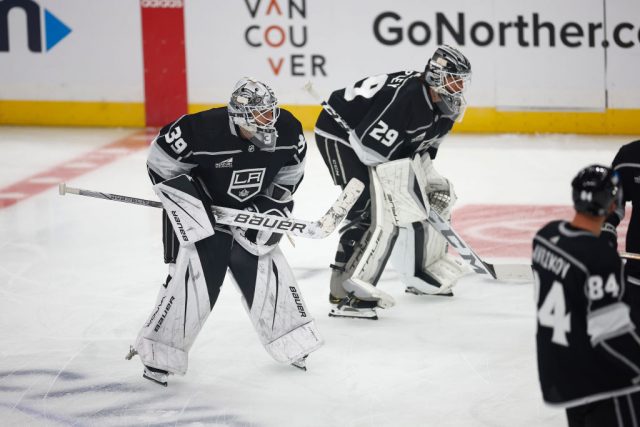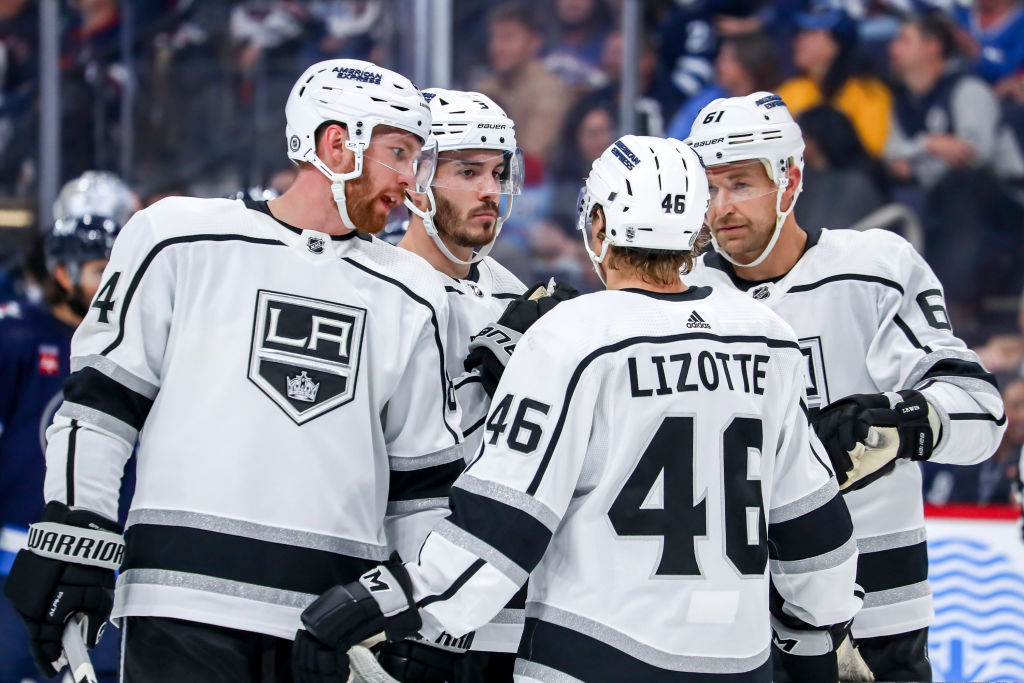The LA Kings are over 90 percent on the penalty kill.
Let me repeat.
The LA Kings are over 90 percent on the penalty kill.
Seven months ago, everyone gathered at Toyota Sports Performance Center for exit interviews, following the team’s six-game series defeat against the Edmonton Oilers, one day after the season ended in Game 6 in Los Angeles. One of the hottest topics of conversation centered around the penalty kill, which allowed nine power-play goals against during the series.
General Manager Rob Blake put it simply – “The penalty kill wasn’t at the level it needed to be against them.”
Head Coach Todd McLellan, more involved with the day-to-day, took a longer approach.
“We have to improve penalty-kill wise, we have to look at the whole package there, who we use, how we do it, how it impacts the goaltenders, where the dangerous shots are coming from, how much is going through the scene. We have a summer project there, so that for me is the biggest concern.”
The summer projects are behind us and with 17 games played, we have enough of a sample size to at least begin to draw conclusions, even if they’re not written in ink just yet. Perhaps the biggest takeaway from the way the Kings have started this season have been the improvements on the penalty kill from last season to this.
The Edmonton series shined a bright spotlight on that unit. While it had some strong stretches throughout the season, it was still below the level, as a whole, that everyone knew was needed. McLellan acknowledged as much. Now, it’s easy to point out what’s gone wrong. We can all do that. What’s harder is actually determining how to fix it.
When you’re on the penalty kill, there’s always going to be something given up. You’re playing with three or four skaters against the opposition’s five, so you can’t be perfect. What the Kings have tried to do, though, has been a new approach to what they’re trying to focus on the most. McLellan has touched on the fact that the Kings have made changes to the “system and structure” so far this season that have changed the way the Kings are approaching man-down situations.
“The process is ongoing,” McLellan said today. “I don’t think we’re completely there yet, but the concepts, rotation and adjustments we made from last year to this year, the players have done obviously done a really good job of comprehending and putting into play.”
When you look at that quote from April, talking about the summer project that faced the Kings, there’s several parts of the equation. It’s still early, but returns thus far have seen an impact on just about every one of those parts, with three key ones broken down below.
Shorthanded on the breakaway? No problem for Juice. 🤫 pic.twitter.com/AHvHPHWehf
— LA Kings (@LAKings) November 19, 2023
“Who We Use”
“Personnel hasn’t changed dramatically, the way we use the personnel has a little bit.”
If you look at the Kings roster, there hasn’t been all that much turnover from last season to this season. Only Pierre-Luc Dubois, Trevor Lewis and Andreas Englund have joined the group amongst the skaters and Lewis is hardly a new face.
He is a new face in terms of last season’s PK personnel to this season’s, though. If you look at the time-on-ice leaders, they show Lewis and forward Blake Lizotte ranking first and second in terms of the Kings forwards. When both players have been in the lineup, we’ll regularly see that duo go over the boards first, bringing their impressive chemistry to the penalty kill as they do at even strength.
Beyond those two, it’s the same, familiar faces – Kopitar, Kempe, Danault and Moore all average over 90 seconds per game of PK time – but perhaps it’s been burdening others with that first assignment that’s not only kept others fresher, but has allowed them to excel in other areas as well. So, the personnel in total is largely the same, yes, but Lewis is making a pretty direct impact.
“I think Trevor Lewis has made a pretty big difference, he’s a pretty trusting guy in that situation,” McLellan added. “Between him and Lizzo, I think they’ve grabbed that part of the game and led it.”
From the outset, the Kings looked to Lizotte and Lewis as key pieces of that unit.
Both players embrace their roles on the PK, both players have taken on that challenge.
“I’ve talked to Yawns a lot about it, he’s talked to me and Lizzo about being a big part of it,” Lewis said. “We kind of took it upon ourselves to just try and get dialed into it right away and we get to work on it more in practice than some of the guys who are on the power play. We’ve tried to be pretty details and focus on it.”
Certainly not the only reason the Kings opted to sign Lewis this summer, but he’s a role player who embraces the role he’s been given and is currently excelling at it.
“How We Do It”
The success of the unit hasn’t changed overnight, but it’s clear that the players are understanding the changes and taking to what’s been implemented.
From the standpoint of structure, it’s taken some time and a lot of work during practice and early games for new concepts to become second nature. There were mistakes early in the season, even if they didn’t necessarily translate into goals against, as the Kings worked through the process of overhauling what they wanted to change. Now, close to 25 percent of the season in, they’re starting to really feel good with what everyone is doing on the ice.
“I think everyone is [comfortable now], we changed the structure a little bit from last year, so it took a little bit of adjusting,” defenseman Mikey Anderson said. “It may not have looked like it, but there were times where it hasn’t felt very natural, but I think now, everyone’s feeling pretty good about what we need to do, what everyone’s role is, whether that’s blocking shots, getting the clear, overall it’s been going good for us.”
In terms of what the structure has done for the Kings, the players bought in almost right away and now they’re applying it to their games.
Players have appreciated the direction that’s been given to them, they’ve bought into the changes that were presented and now they’re executing as intended. How it should work, effectively.
“The staff brought us a new strategy this year, they did their work over the summer to prepare and it’s worked out, their work paid off,” forward Phillip Danault added. “It was our turn to apply it on the ice and we’ve done that, we took care of it and we’re proud to do it. We’re proud to block shots, to clear the puck, the goalies have been outstanding. I think there’s a lot of pride, that’s probably the biggest word.”
Pride in the system is important, but so is execution. The Kings are taking it a step further, by taking pride IN executing. Again, an exercise in how it should be done.

Photo by Ronald Martinez/Getty Images
“How It Impacts The Goaltenders”
Haven’t heard a quote yet from a player or a coach that has not highlighted the goaltending in man-down situations.
And rightfully so.
Kings goaltenders have posted a .939 save percentage on the penalty kill in the early stages of this season, the top mark in the NHL. Natural Stat Trick has the Kings as the NHL’s only team that has not allowed a high-danger goal on the kill, despite 42 HDCA, meaning that not only are the goaltenders making the saves they’re supposed to make, but they’re making them in the dangerous areas as well.
“All too often, your goaltender ends up being your best penalty killer and we’ve been able to get some saves in those situations,” McLellan said.
While last year is last year, the Kings ranked 31 of 32 teams in save percentage on the penalty kill a season ago. Currently, they lead the league. That mark is even more heavily notable because the Kings gave up the third-fewest high-danger chances on the penalty kill last year, per Natural Stat Trick. It’s never just any one factor, but credit the goaltenders for pulling their weight amidst the team-wide changes and improvements.
While Cam Talbot has carried the brunt of the load in the early goings – he ranks second in the NHL in goals saved above average on the PK, per Natural Stat Trick – Pheonix Copley delivered a terrific performance in those situations last time out, on a night when the Kings took six penalties against an Arizona unit that currently ranks sixth in the NHL on the man advantage.
As McLellan said, you want your goaltender to be your best penalty killer. On many nights, that’s been the case for the Kings.
As we look ahead, only the Boston Bruins sit between the Kings and the top of the NHL’s leaderboards. Both teams have allowed six goals this season, though Boston has been shorthanded four additional times. The progress made has been excellent, something the Kings will look to carry with them throughout the course of the season.


Rules for Blog Commenting
Repeated violations of the blog rules will result in site bans, commensurate with the nature and number of offenses.
Please flag any comments that violate the site rules for moderation. For immediate problems regarding problematic posts, please email zdooley@lakings.com.